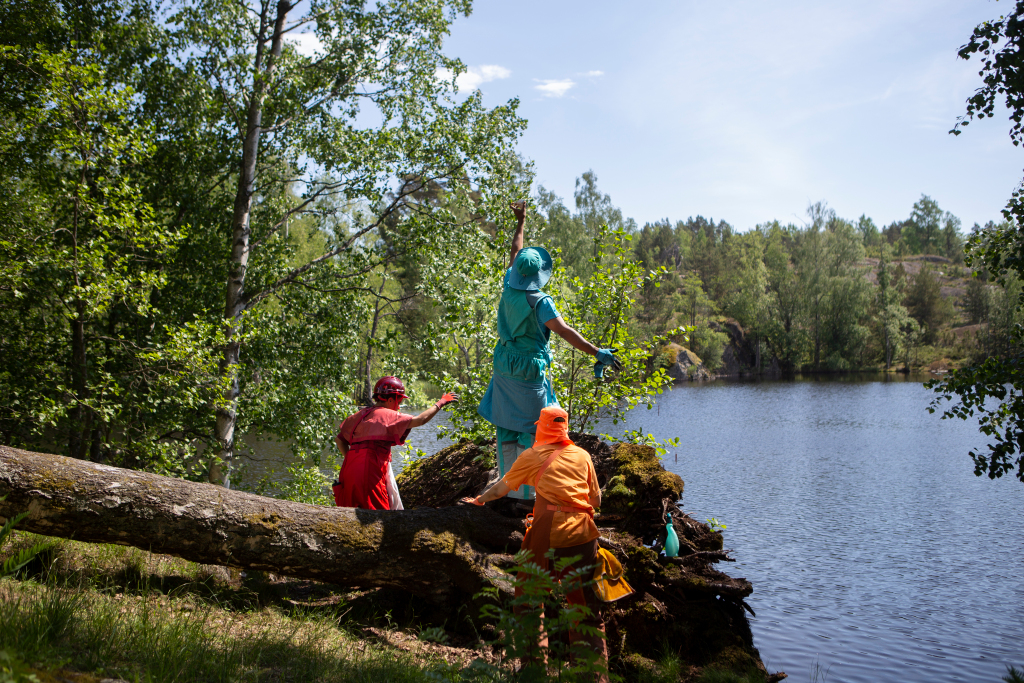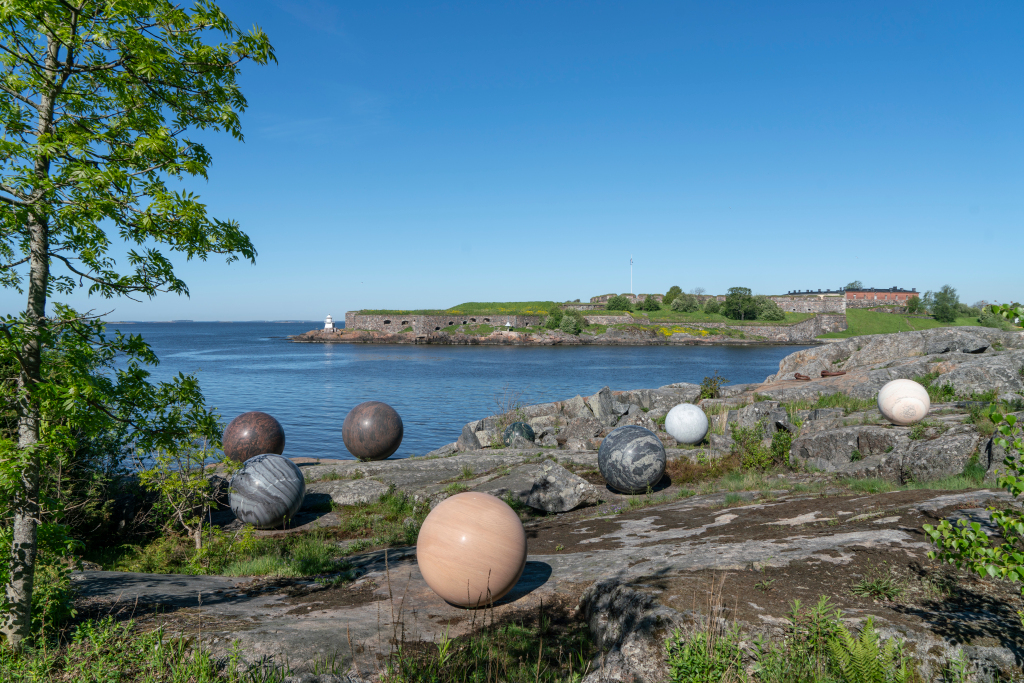 Vallisaari Island skyline. Courtesy Helsinki Biennial
Vallisaari Island skyline. Courtesy Helsinki Biennial
When approaching Vallisaari Island by ferry from Helsinki, a leaky, 20-foot-tall scaffolding with a bright-red roof is one of the first things visitors see. It is not a sign of reconstruction after some weather-related damage, but rather an installation by Finnish artist Jaakko Niemelä titled Quay 6 set to welcome arrivals at the first Helsinki Biennial, whose theme is “The Same Sea.”
Running through September 26 and featuring work from 41 local and international artists, “The Same Sea” centers on universal, environmental, and interpersonal levels of interdependence and interconnectedness. Every element of Quay 6 perfectly embodies this theme: Remove remove any single building block, and the whole structure will collapse. Nor is the piece’s height an arbitrary choice: Global sea levels are expected to rise that much should the Greenland ice cap melt, and what appears to be a leaky roof also references the looming threat of water.
At first glance, with its hiking trails and lush vegetation, Vallisaari Island appears to be a nature lover’s paradise, in stark contrast to the artifice of man-made art. It is the habitat of 400 plant species, 1,000 butterfly species, and a wide variety of protected species of bat. It’s also a former sea fort: upon Finland’s gaining independence from Russia in 1917, it became a preferred storage area for Defense Forces weaponry, as evidenced by gunpowder-storage bunkers. Civilians lived here too, particularly between the 1950s and 1980s; the island even had its own elementary school.
 Samir Bhowmik: Lost Islands, 2021. ©Maija Toivanen/HAM/Helsinki Biennial 2021
Samir Bhowmik: Lost Islands, 2021. ©Maija Toivanen/HAM/Helsinki Biennial 2021
But it’s more than a scenic backdrop. Each artwork uses the natural morphology, wildlife, and man-made structures as integral parts, with artists actively engaging with the island and its post-apocalyptic beauty, where nature has prevailed. “The so-called Anthropocene is long past” is the premise of Samir Bhowmik’s Lost Islands, an immersive piece both performance and installation in which Bhowmik, acting as tour guide, follows the route of an imaginary subterranean and underwater cable through the island of Vallisaari; it explores the area’s wilderness through ruins, attics, cellars, and bunkers, interspersed with Bhowmik’s installations.
All the other works are also devised with exploration in mind, situated as they are along a cannon path and in interiors including gunpowder cellars and deserted residential buildings. Katharina Grosse’s Shutter Splinter, for example, uses the island’s schoolhouse as a canvas, her highly saturated color palette bleeding onto the roof gutter and surrounding vegetation.
Conversely, Alicja Kwade, whose focus is the materiality and the emptiness of matter and the coexistence of those two states, exhibits two works at the Biennial. Pars pro Toto (2018) is a collection of eight smooth, perfectly spherical rocks “scattered” on the rocky Vallisaari shore. Their number and differing sizes are reminiscent of our solar system’s planets, and their natural stone substance comes from and symbolizes all the continents. With Pars pro Toto, Kwade attempts to contextualize the relative magnitude of the issues that plague humankind. Her other work, Big Be-Hide (2019), set on the narrow strip of land that connects Vallisaari to the neighboring Kuninkaansaari, has two rocks—one real, the other a metallic mirror image—placed on either side of a steel sheet with a two-sided reflective surface.
 Alicja Kwade: Pars pro Toto, 2018. ©Maija Toivanen/HAM/Helsinki Biennial 2021
Alicja Kwade: Pars pro Toto, 2018. ©Maija Toivanen/HAM/Helsinki Biennial 2021
Finnish artist Laura Könönen also chose rock as source material, in this case, diorite. Her No Heaven Up in the Sky (2011) represents shards of the sky’s vault having crashed to earth: the upper sides of the pieces are painted sky blue. A representation of change, it challenges conventional thinking, our sense of security, and our beliefs or ways of life that turn out to be unsustainable and irreversibly broken.
Metaphorically connecting the aboveground installations and the underground infrastructure is Tadashi Kawamata’s Vallisaari Lighthouse, a structure made from scrap lumber and other remnants. It rests on a platform over—and seems actually to rise from—an elevator shaft that connects to the island’s numerous subterranean passages.
Cavernous vaulted spaces both subterranean and aboveground provide sites as ideal for Biennial installations as the island’s sweeping vistas, accommodating representations of the ocean bottom, the underground, and the inner dimension of humankind (literally). One such example is Crochet Coral Reef, the work of American artists Margaret and Christine Wertheim; the sisters combine science, geometry, physics, and handicraft in their art practice, employing aesthetic and manual manipulation to render abstract concepts tangible. At the same time, their work calls attention to the progressive destruction of coral reefs owing to climate change.
 Margaret & Christine Wertheim and the Institute for Figuring: Helsinki Satellite Reef, 2021. ©Maija Toivanen/HAM/Helsinki Biennial 2021
Margaret & Christine Wertheim and the Institute for Figuring: Helsinki Satellite Reef, 2021. ©Maija Toivanen/HAM/Helsinki Biennial 2021
Founders of the Los Angeles–based Institute for Figuring, the Wertheim sisters initiated the world’s largest participatory art and science project in the creation of giant coral sculptures incorporating such materials as discarded chicken wire, videotape, and plastic bags and thread—the very stuff of ocean pollution. Part of a global effort, local citizen participants get together to make individual crocheted pieces that are later assembled into large-scale sculpture. The communal work highlights humans’ destructive effects on ecology and climate, and their attendant power to reverse them. The Helsinki Satellite Reef (2021) is the result of the Wertheims’ local engagement involving more than 3,000 area residents.
Maaria Wirkkala’s installation Not So Innocent is another nod to water, sited in the vaulted cellar of the Alexander Battery. Comprising smashed glass, riot stones, gold, and artificial light, it is reminiscent of a large body of water flooding an enclosed space, evoking both destruction and the catharsis that ensues.
The interconnectedness tangible in Niemelä’s Quay 6 is mirrored in Tuomas A. Laitinen’s ΨZone, which, through dioramas and table scapes incorporating microbiological elements, alchemical illustrations, glass, video, and audio transmitted via ultrasonic speakers, aims to explore the porous boundaries between beings.
 Dafna Maimon: Indigestibles, 2021. ©Maija Toivanen/HAM/Helsinki Biennial 2021
Dafna Maimon: Indigestibles, 2021. ©Maija Toivanen/HAM/Helsinki Biennial 2021
One work that focuses more on the individual than on the universal is Dafna Maimon’s immersive installation Indigestibles. In a diverse practice, Maimon examines the way we fictionalize our own traumas in order to emerge more empowered, and, in Indigestibles, this predicament takes the shape of a middle-aged woman’s innards, her intestines—laid out in the underground vaults of Vallisaari Island—a landscape featuring bacteria and undigested food. It’s a ruddy, disquieting environment.
The Helsinki Biennial also attempts to reckon with the history of its own country, especially when it pertains to the indigenous population: the Sámi people’s cultural and artistic relationship with nature, and with the politics of sustainable development. In a first collaboration with her daughters, Birit and Katja Haarla, graduates of the Ballet School of the Finnish National Opera and Ballet, she designed a soundscape with dance, music, and traditional Sámi crafts. Their Guhte gullá / Here to hear (2021) envisions an escapist scenery where young people break into dance to stave off the angst of world destruction, summoning the aid of forgotten Sámi earth deities through the music of Tuomo Puranen, combining ritual and electronic beat, and Mari Boine’s yoik, a wordless Sámi vocal expression.
Upon completion of the Biennial, three artworks will be placed on permanent display. Alicja Kwade’s Big Be-Hide and Pars pro Toto will reside in the Helsinki neighborhood of Kalasatama. Laura Könönen’s No Heaven up in the Sky will move to Hyväntoivonpuisto Park in the Helsinki district of Jätkäsaari.
The Helsinki Biennial overall perfectly encapsulates the art world’s post-pandemic reality, its setting ideal for appreciating the art while observing appropriate public health measures. It reminds us too that we coexist in interdependence, and that our survival depends on mutual effort on an individual and collective basis.
Follow Helsinki Biennial on Instagram. “The Same Sea” runs through September 26, 2021.
Source link : https://www.artnews.com/art-news/sponsored-content/helsinki-biennial-vallisaari-island-1234597895












